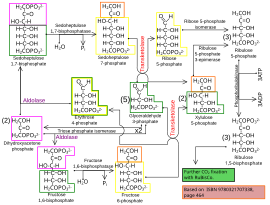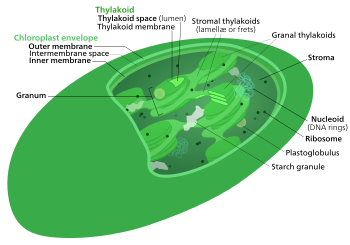Calvin cycle
The Calvin cycle, light-independent reactions, bio synthetic phase, dark reactions, or photosynthetic carbon reduction (PCR) cycle
Though it is also called the "dark reaction," the Calvin cycle does not actually occur in the dark or during night time. This is because the process requires NADPH, which is short-lived and comes from light-dependent reactions. In the dark, plants instead release sucrose into the phloem from their starch reserves to provide energy for the plant. The Calvin cycle thus happens when light is available independent of the kind of photosynthesis (C3 carbon fixation, C4 carbon fixation, and crassulacean acid metabolism (CAM)); CAM plants store malic acid in their vacuoles every night and release it by day to make this process work.[2]
Coupling to other metabolic pathways
The reactions of the Calvin cycle are closely coupled to the thylakoid electron transport chain, as the energy required to reduce the carbon dioxide is provided by NADPH produced during the light dependent reactions. The process of photorespiration, also known as C2 cycle, is also coupled to the Calvin cycle, as it results from an alternative reaction of the RuBisCO enzyme, and its final byproduct is another glyceraldehyde-3-P molecule.
Calvin cycle
carbon fixation
The Calvin cycle, Calvin–Benson–Bassham (CBB) cycle, reductive pentose phosphate cycle (RPP cycle) or C3 cycle is a series of ]Photosynthesis occurs in two stages in a cell. In the first stage, light-dependent reactions capture the energy of light and use it to make the energy-storage molecule NADPH. The Calvin cycle uses these compounds to convert carbon dioxide and water into organic compounds[4] that can be used by the organism (and by animals that feed on it). This set of reactions is also called carbon fixation. The key enzyme of the cycle is called RuBisCO. In the following biochemical equations, the chemical species (phosphates and carboxylic acids) exist in equilibria among their various ionized states as governed by the pH.[citation needed ]
The enzymes in the Calvin cycle are functionally equivalent to most enzymes used in other metabolic pathways such as gluconeogenesis and the pentose phosphate pathway, but the enzymes in the Calvin cycle are found in the chloroplast stroma instead of the cell cytosol, separating the reactions. They are activated in the light (which is why the name "dark reaction" is misleading), and also by products of the light-dependent reaction. These regulatory functions prevent the Calvin cycle from being respired to carbon dioxide. Energy (in the form of ATP) would be wasted in carrying out these reactions when they have no net productivity.[citation needed] The sum of reactions in the Calvin cycle is the following:[citation needed]
glyceraldehyde-3-phosphate (G3P).[citation needed ]
StepsIn the first stage of the Calvin cycle, a CO2 molecule is incorporated into one of two three-carbon molecules ( NADPH, which had been produced in the light-dependent stage. The three steps involved are:[citation needed ]
 
 The next stage in the Calvin cycle is to regenerate RuBP. Five G3P molecules produce three RuBP molecules, using up three molecules of ATP. Since each CO2 molecule produces two G3P molecules, three CO2 molecules produce six G3P molecules, of which five are used to regenerate RuBP, leaving a net gain of one G3P molecule per three CO2 molecules (as would be expected from the number of carbon atoms involved).[citation needed]   The regeneration stage can be broken down into a series of steps.
Thus, of six G3P produced, five are used to make three RuBP (5C) molecules (totaling 15 carbons), with only one G3P available for subsequent conversion to hexose. This requires nine ATP molecules and six NADPH molecules per three CO  RuBisCO also reacts competitively with O ProductsThe immediate products of one turn of the Calvin cycle are 2 glyceraldehyde-3-phosphate (G3P) molecules, 3 ADP, and 2 NADP+. (ADP and NADP+ are not really "products". They are regenerated and later used again in the light-dependent reactions). Each G3P molecule is composed of 3 carbons. For the Calvin cycle to continue, RuBP (ribulose 1,5-bisphosphate) must be regenerated. So, 5 out of 6 carbons from the 2 G3P molecules are used for this purpose. Therefore, there is only 1 net carbon produced to play with for each turn. To create 1 surplus G3P requires 3 carbons, and therefore 3 turns of the Calvin cycle. To make one glucose molecule (which can be created from 2 G3P molecules) would require 6 turns of the Calvin cycle. Surplus G3P can also be used to form other carbohydrates such as starch, sucrose, and cellulose, depending on what the plant needs.[9] Light-dependent regulationThese reactions do not occur in the dark or at night. There is a light-dependent regulation of the cycle enzymes, as the third step requires NADPH.[10] There are two regulation systems at work when the cycle must be turned on or off: the RuBisCo enzyme activation, active in the Calvin cycle, which involves its own activase.[11]
The thioredoxin/ferredoxin system activates the enzymes glyceraldehyde-3-P dehydrogenase, glyceraldehyde-3-P phosphatase, fructose-1,6-bisphosphatase, sedoheptulose-1,7-bisphosphatase, and ribulose-5-phosphatase kinase, which are key points of the process. This happens when light is available, as the ferredoxin protein is reduced in the photosystem I complex of the thylakoid electron chain when electrons are circulating through it.[12] Ferredoxin then binds to and reduces the thioredoxin protein, which activates the cycle enzymes by severing a cystine bond found in all these enzymes. This is a dynamic process as the same bond is formed again by other proteins that deactivate the enzymes. The implications of this process are that the enzymes remain mostly activated by day and are deactivated in the dark when there is no more reduced ferredoxin available.[citation needed] The enzyme RuBisCo has its own, more complex activation process. It requires that a specific RuBP and leads to a non-functional state if left uncarbamylated. A specific activase enzyme, called RuBisCo activase, helps this carbamylation process by removing one proton from the lysine and making the binding of the carbon dioxide molecule possible. Even then the RuBisCo enzyme is not yet functional, as it needs a magnesium ion bound to the lysine to function. This magnesium ion is released from the thylakoid lumen when the inner pH drops due to the active pumping of protons from the electron flow. RuBisCo activase itself is activated by increased concentrations of ATP in the stroma caused by its phosphorylation.[13]
References
Further reading
External links
|

